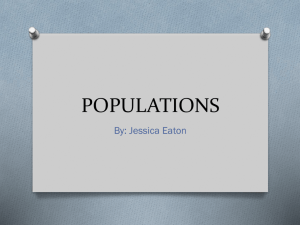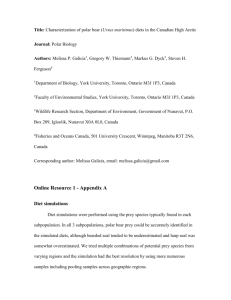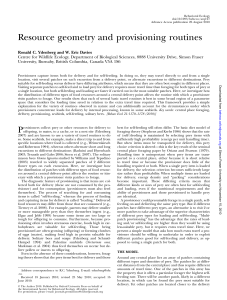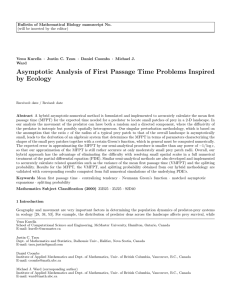PPT - Osenberg Lab
advertisement
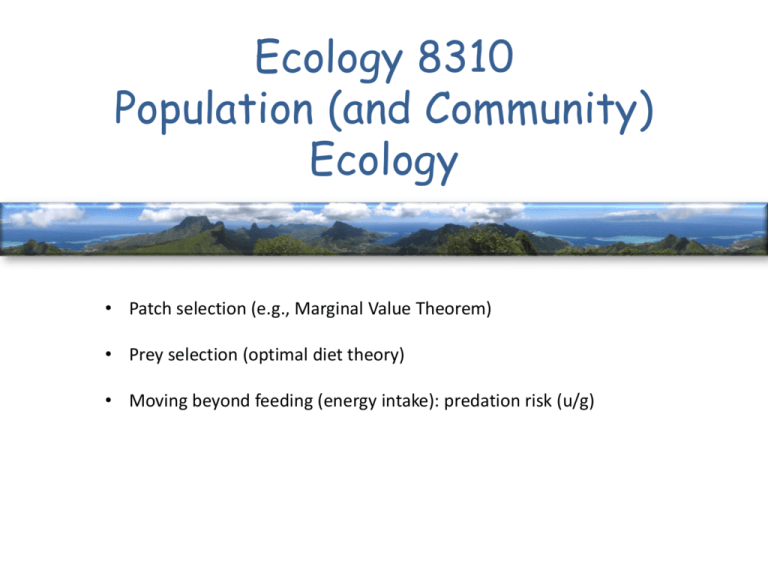
Ecology 8310 Population (and Community) Ecology • Patch selection (e.g., Marginal Value Theorem) • Prey selection (optimal diet theory) • Moving beyond feeding (energy intake): predation risk (u/g) Patch selection: • Consider a forager moving among many patches during a foraging bout (rodent among seed caches, pollinator among flowers, etc.) • Which patches does it feed in? • For how long? (when does it leave?) • How are these decisions altered by patch density? • Or the quality of other patches? Patch selection: Patch selection: GOAL: Maximize rate of net energy gain (intake – losses / time) Cumulative energy intake Patch selection: Patch selection: Marginal Value Theorem: Leave when: dg/dT = En* Marginal Value Theorem: Another way to look at this (when there is only 1 patch type) Slope = Energy gain/Time Point of diminishing Which strategy yields the greatest E/T?returns Time to leave! Travel Time Search Time in Patch Time Marginal Value Theorem: What if patches are denser (travel time is less)? Dense Sparse Leave earlier when travel time is shorter. Travel Time Search Time in Patch Time Patch selection: Predictions of MVT: 1. 2. 3. 4. Leave at a fixed MV (indep. of patch quality Stay in higher quality patches longer Skip patches in which dg/dt|t=0 < En* As the density of patches increase… a. Reduce residency time b. Drop low quality patches from diet 5. Variants: a. Giving up density (uniform among patches) b. Giving up time (time since last prey taken) Prey selection: Prey selection: • Consider a forager moving WITHIN a patch • Which prey does it attack? • How are these decisions altered by prey density? • …or the types of prey available? • Assume: energy maximization Prey selection: Assume a forager has Ts units of search time available. How can we express the rate of net energy gain to that forager during the foraging bout? Two main components: Net energy gained (intake – losses) Time expended (searching and handling) En/T = Net energy gained / Time expended Prey selection: k En /T = Ts å ai ei Ni Pi i=1 k Ts +Ts å ai Ni Pi hi i=1 k = åa e N P i i i=1 k i i 1+ å ai Ni Pi hi i=1 Prey selection: The solution and insights: • Rank prey by ei/hi (=profitability) • Predator can only decide on Pi's (attack, don't attack, sometimes attack). • Optimal Pi is either 0 or 1 (attack or don't attack) • RULE: Attack if ei/hi>E*/T; else ignore. [As in MVT] • Inclusion of a prey type in the diet is only a function of density of MORE valuable prey. • Examine graphically…. A test: From Richardson and Verbeek (1986) Laboratory test: Bluegill sunfish Based upon Werner and Hall (1974) Prey selection: Field (lake) From Mittelbach (1981) Can we use the diet model to predict field patterns (growth and habitat use)? Habitat selection: "Field" (Ponds) Open water Vegetation From Werner et al (1983 Problems? Early models were very simple Ignored complexities (e.g., capture probability, search images, nutrients, etc.) Other species …. Lakes: Open water often the most profitable. Used by large bluegill. BUT small bluegill use the vegetated habitat. Why? Can we incorporate predation risk into our predictive framework? Old rule: maximize "g" (growth) New rule: minimize /g (risk to growth) Other implications of this work (stage-structure in bluegill)? Small Bluegill Littoral Invertebrates Large Bluegill Zooplankton Small Bluegill Littoral Invertebrates Large Bluegill Zooplankton


